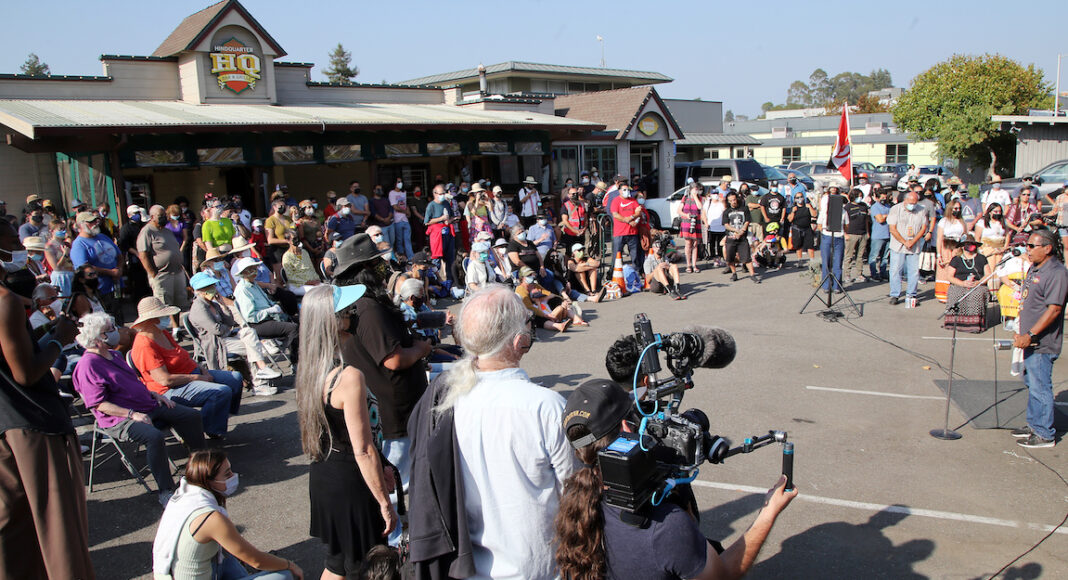In the early 1900s, a series of bell markers were installed along the El Camino Real, a stretch of road connecting Spanish missions, presidios and pueblos. The bells, hung on supports in the form of a shepherd’s crook, were meant to attract automobile tourism to the missions.
Hundreds of bells now line various roads between San Diego and Sonoma counties.
But for some Indigenous populations, these bells are not nostalgic symbols of a bygone era. Instead, they are a representation of the suffering and dehumanization of their ancestors at the hands of Catholic missionaries.
“History says that we needed missions because we were savages and we needed religion,” says Carolyn Rodriguez, a youth group leader with the Amah Mutsun Tribal Band. “But we had our religion. We had our own way of life. We didn’t need to be forced into another one.”
On Saturday, the Tribal Band led a ceremony to signify the removal of a bell marker from the intersection of Soquel and Dakota avenues in Santa Cruz, which is now the first city in California to remove all bells from public property. The Tribal Band is comprised of descendants of the tribal groups who fell under the influence of the San Juan Bautista and Santa Cruz missions in the 18th, 19th and 20th centuries.
Originally, the Tribal Band planned to remove the bell following a public speaking event at Mission Plaza Park and a procession to the site. But late Friday night or early Saturday morning, the bell was stolen.
Santa Cruz Police Chief Andy Mills confirmed the theft on Saturday. Mills said police do not yet have any suspects, but they did collect evidence and are searching for surveillance footage.
“We believe we will be able to make some progress in the not too distant future,” he says. “We certainly will investigate the hate crime aspect of this, should it be a hate crime. [Saturday] we are making a visual presence so people feel comfortable and safe.”
Former Santa Cruz Mayor Justin Cummings spoke out against the theft of the bell at the rally in Mission Plaza before a crowd of about 400 people.
“I strongly condemn the illegal removal of the bell in the cover of night,” he said. “These types of shameful acts are not acceptable. This is a time to honor all Indigenous people. Today we are not here to cancel history, but to get it right.”
Valentin Lopez, Chair of the Tribal Band, says the theft does not matter in the long run.
“It was going to come down anyways,” Lopez says. “The most important thing is that it has been removed. The ceremony was a time for prayer and for the community to come together. It was a time to acknowledge the true history of the missions and move towards healing.”
He also says that the removal did not change the ceremony “in any way.”
“We had the same prayer, same speakers and same message,” he says. “[It] brought Native peoples and non-Natives together to reflect, pray, to learn, and to recognize it is time for change and time for healing.”
In November 2020, the Santa Cruz City Council voted unanimously to remove the bell on Soquel Avenue. This followed another ceremony in 2019, when one was removed from the UCSC campus.
“This is about showing the true history of what Indigenous people went through,” Rodriguez says. “Removing the bells signifies that we are stepping away from incorrect myths we were taught in school about the mission system. We are now focusing on the Indigenous perspective, and how that leads into modern-day—how we are still struggling today.”
Prior to the ceremony (and the premature removal), Rodriguez said she expected some people would claim that removing the bells would delete important parts of California history.
“But we’re not taking away anything that’s actually true,” she says. “Often people don’t want to think about the ugly side of history…They have a hard time coming to terms with the violence that happened. People might also say missions were necessary for the development of the U.S. But it wasn’t. We were dehumanized. We had no rights. They looked at us as if we had no soul. Keeping those bells, it glorifies that history.”
The bell was replaced Saturday with an informational metal sign that describes the reasons for its removal. The sign will eventually be replaced by a permanent memorial which will be developed by the Tribal Band and the city of Santa Cruz.
Lopez said the Tribal Band is continuing its work in removing more bell markers statewide. This includes a campaign asking for bells on state property to be removed.
“We hope to talk to other California Natives impacted by the missions and to continue working with the tribes that attended the ceremony,” he says. “We hope to develop a path for talking to representatives and government officials about the need to remove the bells and why it is important.”
Added Rodriguez: “Santa Cruz is leading by example. But there are still many bells out there. I hope that this change will lead the way to take more of the bells down, and create more healing for more communities.”
For information about the ongoing effort, visit removethebells.org.













We should be proud to remove swastikas